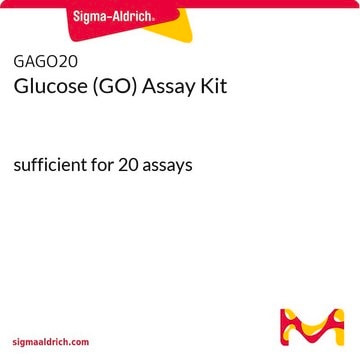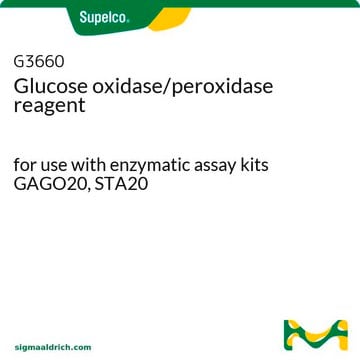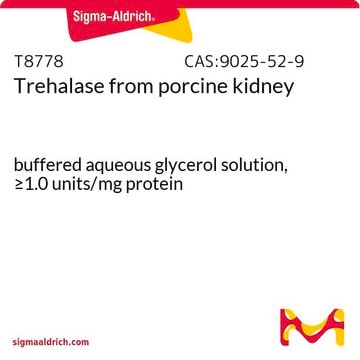If this product has an expiration or retest date, it will be shown on the Certificate of Analysis (COA, CofA). If there is no retest or expiration date listed on the product's COA, we do not have suitable stability data to determine a shelf life. For these products, the only date on the COA will be the release date; a retest, expiration, or use-by-date will not be displayed.
For all products, we recommend handling per defined conditions as printed in our product literature and website product descriptions. We recommend that products should be routinely inspected by customers to ensure they perform as expected.
For products without retest or expiration dates, our standard warranty of 1 year from the date of shipment is applicable.
For more information, please refer to the Product Dating Information document: https://www.sigmaaldrich.com/deepweb/assets/sigmaaldrich/marketing/global/documents/449/386/product-dating-information-mk.pdf
G3293
Réactif de dosage du glucose
for use with enzymatic assay kits GAHK20, SCA20, FA20, SA20
Sélectionner une taille de conditionnement
75,90 €
Disponible pour expédition le07 avril 2025Détails
Sélectionner une taille de conditionnement
About This Item
75,90 €
Disponible pour expédition le07 avril 2025Détails
Produits recommandés
Classe(s) chimique(s) de l'analyte
sugars (glucose)
Technique(s)
photometry: suitable
Impuretés
≤0.005% Creatine phosphokinase, glutathione reductase, myokinase, NADH-oxidase,NADPH oxidase, phosphogluconic dehydrogenase, phosphoglucose isomerase, lactic dehydrogenase
<0.01% ATP-ase, myokinase
Application(s)
food and beverages
general analytical
Température de stockage
2-8°C
Spécificité
Application
Produit(s) apparenté(s)
Code de la classe de stockage
11 - Combustible Solids
Classe de danger pour l'eau (WGK)
WGK 3
Point d'éclair (°F)
Not applicable
Point d'éclair (°C)
Not applicable
Équipement de protection individuelle
Eyeshields, Gloves, multi-purpose combination respirator cartridge (US)
Faites votre choix parmi les versions les plus récentes :
Certificats d'analyse (COA)
Vous ne trouvez pas la bonne version ?
Si vous avez besoin d'une version particulière, vous pouvez rechercher un certificat spécifique par le numéro de lot.
Déjà en possession de ce produit ?
Retrouvez la documentation relative aux produits que vous avez récemment achetés dans la Bibliothèque de documents.
Protocoles
Enzymatic Assay of α-Glucosidase by the Modified Boehenger Procedure (EC 3.2.1.20)
To standardize an enzymatic assay procedure of cellulase.
This procedure may be used for the determination of Amyloglucosidase activity using starch as the substrate.
-
How can I determine the shelf life / expiration / retest date of this product?
1 réponse-
Utile ?
-
-
How is shipping temperature determined? And how is it related to the product storage temperature?
1 réponse-
Products may be shipped at a different temperature than the recommended long-term storage temperature. If the product quality is sensitive to short-term exposure to conditions other than the recommended long-term storage, it will be shipped on wet or dry-ice. If the product quality is NOT affected by short-term exposure to conditions other than the recommended long-term storage, it will be shipped at ambient temperature. As shipping routes are configured for minimum transit times, shipping at ambient temperature helps control shipping costs for our customers. For more information, please refer to the Storage and Transport Conditions document: https://www.sigmaaldrich.com/deepweb/assets/sigmaaldrich/marketing/global/documents/316/622/storage-transport-conditions-mk.pdf
Utile ?
-
-
For how many tests this reagent will be sufficient?
1 réponse-
This product is available in a 20 mL or 50 mL package size. The entire vial should be reconstituted in DI water as indicated by the package size. Each test requires 1 mL of this reagent. The 20 mL package size is sufficient to perform 20 test and the 50 mL pack size is sufficient to perform 50 tests.
Utile ?
-
-
How much of the initial must be reconstituted in 20 ml of DI water?
1 réponse-
The entire vial should be reconstituted to the volume of the package size. The G3293-20 mL with 20 mL of DI water and the G3293-50 mL with 50 mL of DI water.
Utile ?
-
-
Is magnesium required for Product G3293, Glucose Assay Reagent?
1 réponse-
Magnesium, an activator of hexokinase, is included in the assay reagent. There is no need to add a magnesium salt to the reagent before use.
Utile ?
-
-
What is the Department of Transportation shipping information for this product?
1 réponse-
Transportation information can be found in Section 14 of the product's (M)SDS.To access the shipping information for this material, use the link on the product detail page for the product.
Utile ?
-
-
Is it possible to adapt Product G3293, Glucose Assay Reagent, for use with a 96 well plate reader?
1 réponse-
In principle, it should be possible to adapt assay procedures using this reagent to 96-well plate readers. Volumes of reagent, water, standard, and unknown should be reduced to fit the capacity of the test wells, and kept in the same proportions as those used with a spectrophotometer. The volume reduction will likely be 1:4 or 1:5. With the shorter "pathlength" of a multiwell plate, the sensitivity of the assay would likely decrease.
Utile ?
-
-
What is the detection limit of Product G3293, Glucose Assay Reagent?
1 réponse-
This reagent should be able to detect glucose down to approximately 0.01 mg/mL using a spectrophotometer with a 1 cm path length.
Utile ?
-
Filtres actifs
Notre équipe de scientifiques dispose d'une expérience dans tous les secteurs de la recherche, notamment en sciences de la vie, science des matériaux, synthèse chimique, chromatographie, analyse et dans de nombreux autres domaines..
Contacter notre Service technique







